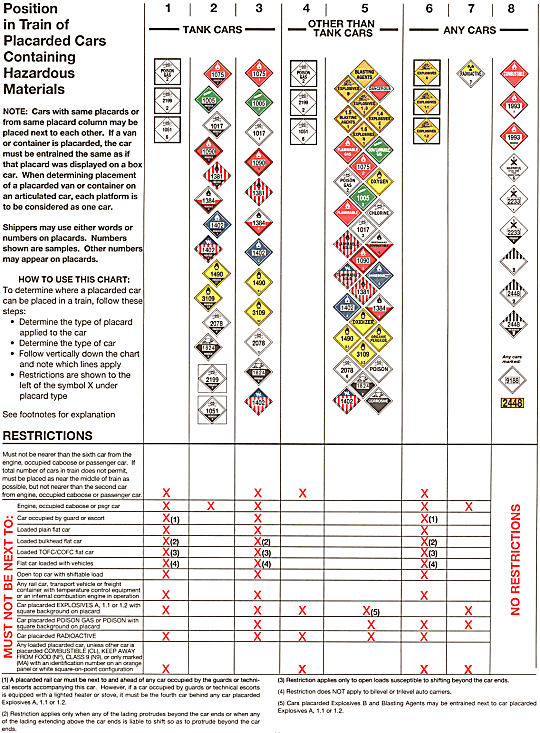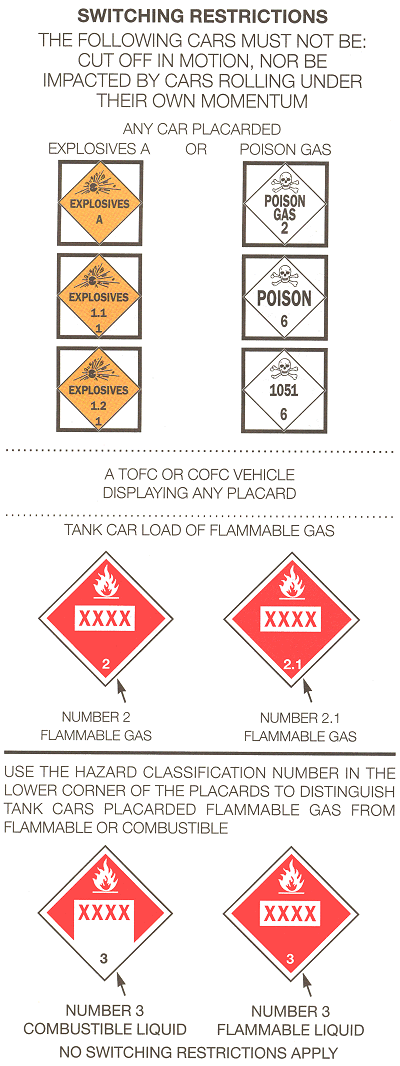- SHIPPING PAPER REQUIREMENTS:
A train crew must have a copy of the shipping papers for all hazardous materials being transported. A shipping paper may be in the form of a shipping order, bill of lading, manifest or other shipping document containing the following information:
- Placard endorsement.
- The car number.
- The total quantity by weight, volume, or as otherwise appropriate (i.e. "1T/C" for one tank car).
- The proper shipping name of material.
- The hazard class specified for the material.
- Identification numbers (UN or NA) as appropriate.
- An R.Q. designation if indicated.
- The placard notation, if required.
- Emergency contact telephone number.
- Emergency Response information.
- Technical name for N.O.S. descriptions.
An "empty" tank car last containing a hazardous material must include words "RESIDUE—LAST CONTAINED:" preceding the shipping name.
The hazardous consist accompanying the train mass profile graph satisfies the shipping paper requirements.
Train crews handling tank cars identified on train consist as commodity "SP HAZ" must have in their possession Material Safety Data Sheet (MSDS) and printout of waybill information with Emergency Response telephone number for each car so designated.
- HANDLING SHIPPING PAPERS ENROUTE:
- The crew must have a document indicating position in train of each placarded car, except when the position is changed or car is added to the train enroute. Such document must be passed to relieving crew at crew change points. When not relieved by outbound crew, documents must be forwarded to yard office ersonnel or left on train as directed by the train dispatcher.
- Unless otherwise advised, when setting out cars containing hazardous materials, appropriate part of the consist indicating shipping description and emergency response information shall be left as directed by the train dispatcher.
- When a crew has not been provided with shipping papers for a hazardous material car to be picked up on line, the crew must obtain information found in Item 1, "SHIPPING PAPER REQUIREMENTS", (except 1(j) not necessary if in possession of "EMERGENCY RESPONSE GUIDEBOOK") by radio or other means from the train dispatcher or yard office. This information must be retained in writing until other appropriate shipping papers are received. If shipping information is not available, the car must not be picked up.
- SWITCHING RESTRICTIONS:
The following switching restrictions apply to loaded placarded cars containing hazardous materials:
- A car placarded EXPLOSIVES A, POISON GAS, a tank car placarded FLAMMABLE GAS, or a flat car carrying a trailer or container displaying any hazardous material placard must not be cut off in motion nor be struck by any car moving under its own momentum, or coupled to with any more force than necessary to make coupling.
- A car placarded EXPLOSIVES A must be separated from the engine by at least one non-placarded car. While in a yard or siding, it must be located so as to be safe from all probable danger of fire and must not be placed under abridge or overhead highway crossing, or alongside a passenger station.
- A loaded placarded car (other than those indicated in Item (a) above) moving over a hump must be released as a single car and must not be coupled to by more than a single car which is moving on its own momentum.
- At locations other than a hump, a loaded tank car identified in shipping papers as "Poison—Inhalation Hazard" or in train consist commodity column as "SP HAZ", must not be allowed to move under its own momentum in cuts of more than two cars, or coupled to by cuts of more than two cars moving under their own momentum.
- In switching operations where the use of hand brakes is necessary, a hazardous material car or cut of cars containing a hazardous material car must not be released to move on its own momentum until previously released car(s) have cleared the switching lead or adjacent track. Likewise, other car(s) must not be released until hazardous material car or cut containing a hazardous material car which is moving on its own momentum has cleared the switching lead or adjacent track.
- ENTRAINMENT RESTRICTIONS:
Placarded cars must be properly positioned in a train as outlined in the chart entitled "Position in Train of Placarded Cars Containing Hazardous Materials".
A loaded tank car identified in train consist commodity column as "SP HAZ" must be entrained in the same manner as a loaded tank car placarded "CORROSIVE" (column 3).
An empty tank car identified in train consist commodity column as "SP HAZ" must be entrained in the same manner as an empty tank car placarded "RESIDUE" (column 2).
- UNINTENTIONAL RELEASE OF HAZARDOUS MATERIAL:
Upon discovery of an unintentional release of material from a rail car transporting hazardous material, notify the train dispatcher or supervisor by the first available means of communication, providing information as indicated in "GUIDE FOR REPORTING HAZARDOUS MATERIAL INCIDENTS" in the timetable.

